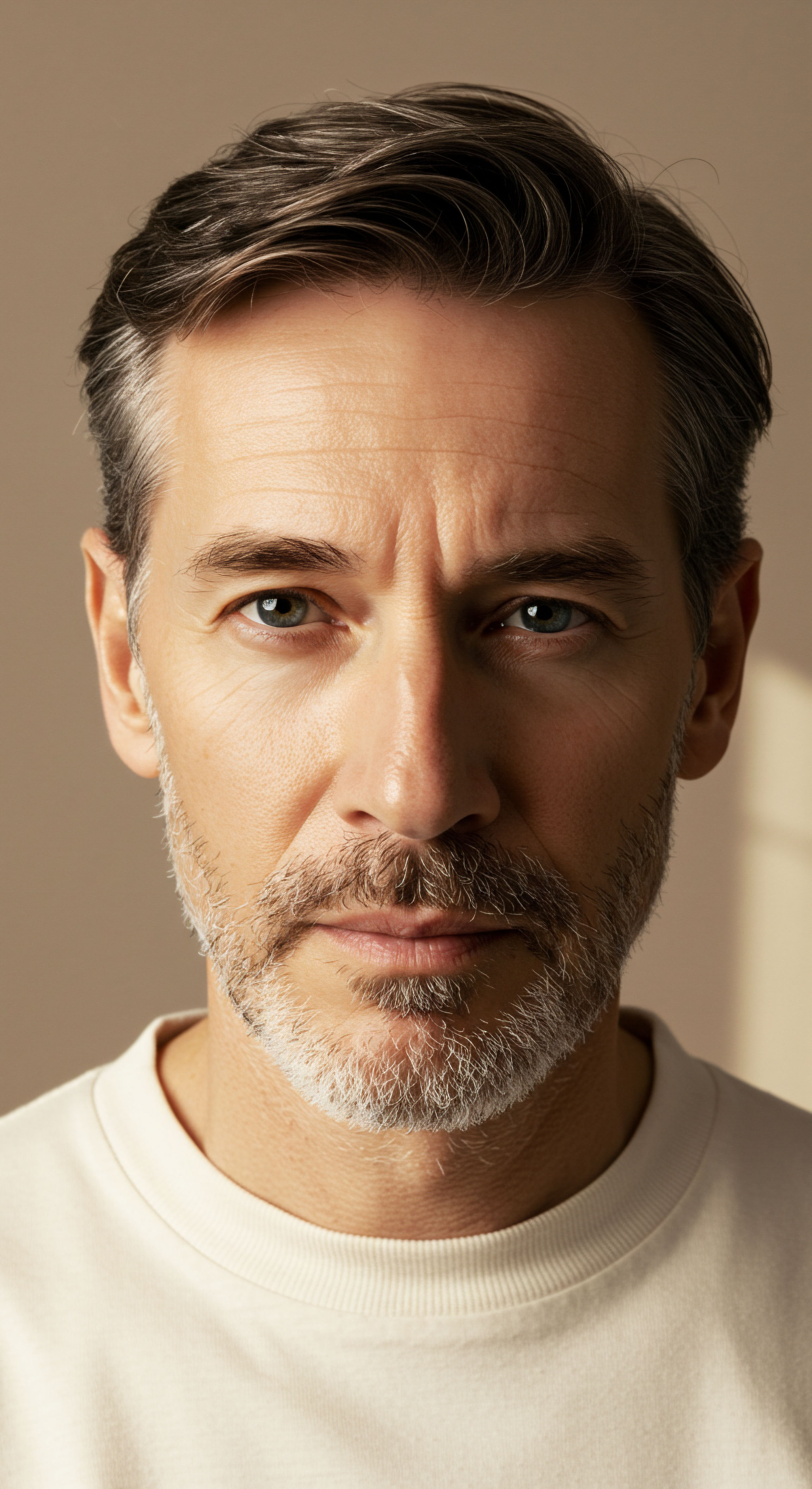

Fundamentals
The reflection in the mirror can begin to feel unfamiliar. A persistent fatigue settles deep into your bones, a mental fog clouds your thoughts, and the vitality that once defined you seems to be gradually receding. You might notice a subtle shift in your body composition, with muscle giving way to fat despite your efforts in the gym. These experiences are not a failure of will.
They are the perceptible, lived-in consequences of complex biological shifts that occur deep within your cells. The question of whether hormonal optimization Meaning ∞ Hormonal Optimization is a clinical strategy for achieving physiological balance and optimal function within an individual’s endocrine system, extending beyond mere reference range normalcy. can reverse this decline is a profound one, touching upon the very mechanisms of aging itself. The answer begins with understanding that your body operates as an intricate communication network, and hormones are its primary messengers.
This network, the endocrine system, is a collection of glands that produce and secrete hormones directly into the bloodstream. Think of it as a sophisticated internal postal service, where hormones are letters carrying specific instructions to target cells throughout the body. These instructions regulate nearly every aspect of your existence, from your metabolic rate and sleep cycles to your mood and reproductive function. As we age, the production of these crucial messengers naturally wanes.
The postal service becomes less efficient, messages are sent less frequently, and the systems they regulate begin to function with less precision. This is the biological reality behind the symptoms of age-related decline.
The gradual decline in hormonal signaling is a primary driver of the physical and cognitive changes associated with aging.

The Key Messengers and Their Roles
To comprehend the potential of hormonal optimization, we must first appreciate the function of the key hormones that diminish over time. These are not isolated molecules; they are part of an interconnected system where the function of one profoundly impacts the others.

Testosterone the Architect of Vitality
While often associated with male characteristics, testosterone is a vital hormone for both men and women. It is a primary driver of libido, muscle mass, bone density, and red blood cell production. Its influence extends to cognitive functions, including mood regulation and mental clarity.
The age-related decline Meaning ∞ Age-related decline refers to the gradual, progressive deterioration of physiological functions and structural integrity that occurs in organisms over time, independent of specific disease processes. in testosterone, known as andropause in men and a key component of the menopausal transition in women, directly correlates with symptoms like reduced energy, loss of muscle strength, and a diminished sense of well-being. For women, testosterone is produced in the ovaries and adrenal glands, and its decline can contribute to low libido and fatigue, symptoms often experienced during perimenopause and post-menopause.

Growth Hormone the Agent of Repair
Human Growth Hormone Meaning ∞ Growth hormone, or somatotropin, is a peptide hormone synthesized by the anterior pituitary gland, essential for stimulating cellular reproduction, regeneration, and somatic growth. (HGH), produced by the pituitary gland, is essential for cellular regeneration and repair. During youth, it drives growth and development. In adulthood, its primary role shifts to maintaining tissue health, supporting metabolism, and promoting recovery.
HGH levels peak in early adulthood and then begin a steady decline. This reduction contributes to changes in body composition, such as increased body fat and decreased muscle mass, as well as reduced skin elasticity and slower recovery from physical exertion.

What Is Hormonal Optimization?
Hormonal optimization is a clinical strategy designed to restore these crucial messenger molecules to levels characteristic of a younger, healthier state. This process involves a detailed evaluation of an individual’s hormonal profile through blood analysis, followed by the administration of bioidentical hormones Meaning ∞ Bioidentical hormones are substances structurally identical to the hormones naturally produced by the human body. or specific signaling molecules to address identified deficiencies. The goal is a recalibration of the body’s internal communication system.
By replenishing the supply of these vital messengers, the aim is to restore the physiological functions they govern, thereby mitigating and potentially reversing the symptoms of age-related decline. It is a proactive approach to wellness, grounded in the principle that restoring biological function can lead to a profound improvement in quality of life.


Intermediate
Understanding that hormonal decline contributes to aging is the first step. The next is to explore the specific clinical protocols designed to counteract this process. These interventions are not a blunt instrument but a series of precise, targeted strategies aimed at recalibrating the body’s complex endocrine signaling pathways.
Each protocol is tailored to the individual’s unique biochemistry, addressing specific deficiencies to restore systemic function. The core principle is to re-establish the physiological environment of youthful vitality by replenishing the body’s key signaling molecules.

Recalibrating the Male Endocrine System
For men experiencing the symptoms of andropause—fatigue, low libido, muscle loss, and cognitive fog—the primary intervention is often Testosterone Replacement Therapy (TRT). The protocol is designed to restore testosterone to optimal levels while managing its downstream effects to maintain a balanced hormonal state.

The Core Components of Male TRT
A comprehensive male optimization protocol typically involves several components working in concert. The administration of exogenous testosterone can suppress the body’s natural signaling cascade, known as the Hypothalamic-Pituitary-Gonadal (HPG) axis. Therefore, ancillary medications are used to maintain the integrity of this system.
- Testosterone Cypionate This is a bioidentical form of testosterone delivered via intramuscular or subcutaneous injection, typically on a weekly basis. It serves as the foundation of the therapy, directly replenishing the primary male androgen.
- Gonadorelin This peptide is a synthetic analog of Gonadotropin-Releasing Hormone (GnRH). It is used to stimulate the pituitary gland to produce Luteinizing Hormone (LH) and Follicle-Stimulating Hormone (FSH). This action helps maintain testicular size and function, preventing the testicular atrophy that can occur with TRT alone.
- Anastrozole Testosterone can be converted into estrogen via an enzyme called aromatase. In some men, TRT can lead to elevated estrogen levels, which can cause side effects like water retention and gynecomastia. Anastrozole is an aromatase inhibitor that blocks this conversion, helping to maintain a healthy testosterone-to-estrogen ratio.
A well-designed TRT protocol for men aims to restore testosterone levels while preserving the natural function of the HPG axis.

Hormonal Balance for Women
The female hormonal landscape is intricate, with fluctuations in estrogen, progesterone, and testosterone defining different life stages. Hormonal optimization for women, particularly during perimenopause Meaning ∞ Perimenopause defines the physiological transition preceding menopause, marked by irregular menstrual cycles and fluctuating ovarian hormone production. and post-menopause, focuses on alleviating symptoms like hot flashes, mood swings, low libido, and sleep disturbances by restoring these key hormones.

Tailored Protocols for Female Wellness
Protocols for women are highly individualized, based on symptoms and lab results. They often involve a combination of hormones to address the multifaceted nature of female endocrine health.
A low dose of Testosterone Cypionate is often prescribed to address symptoms of low libido, fatigue, and lack of motivation. Studies have shown that testosterone therapy Meaning ∞ A medical intervention involves the exogenous administration of testosterone to individuals diagnosed with clinically significant testosterone deficiency, also known as hypogonadism. can improve sexual function and overall well-being in postmenopausal women. Progesterone is also a key component, particularly for women who still have a uterus, as it helps to balance the effects of estrogen and has calming, sleep-promoting properties. These hormones can be administered through various methods, including injections, creams, or long-acting pellets inserted under the skin.
| Component | Typical Male Protocol | Typical Female Protocol |
|---|---|---|
| Primary Hormone | Testosterone Cypionate (e.g. 100-200mg/week) | Testosterone Cypionate (e.g. 10-20 units/week), often with Progesterone |
| System Support | Gonadorelin to maintain HPG axis function | Progesterone to balance estrogen and support mood/sleep |
| Estrogen Management | Anastrozole as needed to control aromatization | Anastrozole may be used with pellet therapy if appropriate |

Peptide Therapy the Next Frontier
Beyond direct hormone replacement, a more nuanced approach involves using peptide therapies to stimulate the body’s own production of hormones. Peptides are short chains of amino acids that act as precise signaling molecules. This approach is often used to enhance Growth Hormone levels, which decline significantly with age.

Stimulating Natural Growth Hormone
Instead of administering synthetic HGH, which can have significant side effects Meaning ∞ Side effects are unintended physiological or psychological responses occurring secondary to a therapeutic intervention, medication, or clinical treatment, distinct from the primary intended action. and shut down natural production, specific peptides are used to stimulate the pituitary gland. This method is considered safer as it works within the body’s natural feedback loops.
- Sermorelin This peptide is a GHRH analog that directly stimulates the pituitary to produce and release HGH. It mimics the body’s natural processes, leading to improvements in body composition, sleep quality, and tissue repair.
- Ipamorelin / CJC-1295 This combination is highly effective. CJC-1295 is a long-acting GHRH analog, providing a steady stimulus to the pituitary. Ipamorelin is a ghrelin mimetic that also stimulates HGH release through a separate pathway, creating a potent synergistic effect. This combination is favored for its ability to produce a strong, sustained increase in HGH levels, leading to enhanced muscle gain, fat loss, and recovery.
These protocols represent a sophisticated, systems-based approach to health. By understanding the specific roles of each hormone and signaling molecule, it becomes possible to design interventions that not only replenish deficiencies but also restore the elegant balance of the entire endocrine system.
Academic
A sophisticated examination of hormonal optimization protocols requires moving beyond the simple restitution of hormone levels to a deeper, systems-biology perspective. The central question is not merely whether these protocols can reverse symptoms, but whether they can fundamentally alter the trajectory of age-related cellular and metabolic dysfunction. The efficacy of these interventions lies in their ability to modulate the intricate crosstalk between the major signaling networks that govern organismal aging, primarily the Hypothalamic-Pituitary-Gonadal (HPG) axis, the insulin/IGF-1 signaling (IIS) pathway, and inflammatory cascades.

The HPG Axis as a Master Regulator of Aging
The age-related decline in gonadal steroids, such as testosterone and estradiol, is a hallmark of mammalian aging. This decline is not an isolated event but rather a systemic failure of the HPG axis, a complex feedback loop involving the hypothalamus (producing GnRH), the pituitary (producing LH and FSH), and the gonads. The Endocrine Society’s clinical practice guidelines acknowledge that restoring testosterone in hypogonadal men can improve bone mineral density, muscle mass, and sexual function, all of which decline with age.
The academic inquiry, however, focuses on the mechanisms. Restoring testosterone levels with exogenous administration, for instance, directly activates androgen receptors in muscle and bone tissue, stimulating protein synthesis Meaning ∞ Protein synthesis is the fundamental biological process by which living cells create new proteins, essential macromolecules for virtually all cellular functions. and inhibiting bone resorption.
However, a truly systemic intervention must also consider the integrity of the feedback loop itself. The use of Gonadorelin in male TRT protocols is a clinical application of this principle. By providing a pulsatile GnRH signal, it prevents the suppression of pituitary LH and FSH output that would otherwise occur with continuous testosterone administration.
This maintains endogenous testicular steroidogenesis and spermatogenesis, preserving a more complete physiological state than testosterone monotherapy. From a systems perspective, this prevents the full collapse of the HPG axis, maintaining its potential for responsiveness.
Hormonal optimization protocols can be viewed as a form of systemic signal restoration, aimed at counteracting the age-related degradation of key endocrine feedback loops.

Interplay with Metabolic and Inflammatory Pathways
The benefits of hormonal optimization extend far beyond their primary targets. There is significant crosstalk between sex hormones and metabolic regulation. Testosterone, for example, has a profound impact on insulin sensitivity and body composition. Clinical trials have demonstrated that TRT in hypogonadal men can decrease visceral fat mass and improve measures of insulin resistance.
This is mechanistically significant because visceral adiposity is a major source of pro-inflammatory cytokines, such as IL-6 and TNF-α. By reducing this adipose tissue, TRT can indirectly attenuate the chronic, low-grade inflammation (often termed “inflammaging”) that is a key driver of age-related diseases.
The use of aromatase inhibitors like Anastrozole further refines this metabolic modulation. While primarily used to control estrogen levels and prevent side effects, maintaining an optimal testosterone-to-estrogen ratio is critical for metabolic health. Both excessively high and excessively low levels of estradiol in men have been associated with adverse metabolic outcomes. Therefore, the judicious use of Anastrozole Meaning ∞ Anastrozole is a potent, selective non-steroidal aromatase inhibitor. is a tool for fine-tuning the metabolic environment, not just managing symptoms.
| Intervention | Primary Mechanism | Systemic Effect |
|---|---|---|
| Testosterone Cypionate | Activation of androgen receptors in target tissues (muscle, bone, brain). | Increases protein synthesis, improves insulin sensitivity, reduces visceral fat. |
| Gonadorelin | Pulsatile stimulation of pituitary gonadotrophs to release LH and FSH. | Maintains HPG axis integrity, preserves endogenous testicular function. |
| Anastrozole | Inhibition of the aromatase enzyme, blocking conversion of testosterone to estradiol. | Optimizes testosterone-to-estrogen ratio, mitigating estrogen-related side effects and metabolic dysfunction. |
| Sermorelin/CJC-1295 | Stimulation of pituitary somatotrophs to release Growth Hormone. | Increases IGF-1, promotes lipolysis, enhances cellular repair and protein synthesis. |

Can Peptide Therapies Reverse Cellular Aging?
Peptide therapies that stimulate Growth Hormone Secretagogues (GHSs), such as the combination of CJC-1295 and Ipamorelin, represent another layer of intervention. They work by stimulating the pituitary to release HGH, which in turn stimulates the liver to produce Insulin-like Growth Factor 1 (IGF-1). The IIS pathway is one of the most conserved aging-regulatory pathways in biology. While chronic hyperactivation of this pathway can accelerate aging, the pulsatile release of HGH and IGF-1 induced by these peptides may have a different effect.
It promotes cellular repair, enhances protein synthesis, and improves lipolysis, effectively counteracting the sarcopenia and increased adiposity of aging. The use of GHSs, rather than direct HGH administration, is a critical distinction. It preserves the pituitary’s natural pulsatility and feedback regulation, potentially avoiding the adverse effects associated with continuous, high levels of HGH. This approach aligns with a model of restoring youthful signaling patterns, not just elevating hormone levels.
Ultimately, the potential for these protocols to “reverse” age-related decline depends on the definition of reversal. While they cannot turn back the chronological clock, the available evidence strongly suggests they can reverse many of the functional and metabolic hallmarks of aging. By recalibrating the key endocrine axes that govern cellular health, these protocols can restore a physiological state that is more characteristic of a younger organism, leading to marked improvements in function, body composition, and overall vitality.
References
- Bhasin, S. et al. “Testosterone Therapy in Men With Hypogonadism ∞ An Endocrine Society Clinical Practice Guideline.” The Journal of Clinical Endocrinology & Metabolism, vol. 103, no. 5, 2018, pp. 1715–1744.
- dos Santos, M. R. & Bhasin, S. “Benefits and Risks of Testosterone Treatment in Men with Age-Related Decline in Testosterone.” Annual Review of Medicine, vol. 72, 2021, pp. 75-91.
- Garnick, M. B. “Testosterone Replacement Therapy in Men ∞ A Clinical Update.” The New England Journal of Medicine, vol. 373, no. 2, 2015, pp. 163-174.
- Vigersky, R. A. et al. “The Utilization and Impact of Aromatase Inhibitor Therapy in Men With Elevated Estradiol Levels on Testosterone Therapy.” The Journal of Sexual Medicine, vol. 18, no. 6, 2021, pp. 1093-1100.
- Panay, N. et al. “Global Consensus Position Statement on the Use of Testosterone Therapy for Women.” Climacteric, vol. 22, no. 5, 2019, pp. 429-437.
- Sigalos, J. T. & Zito, P. M. “Sermorelin.” StatPearls, StatPearls Publishing, 2023.
- Fields, D. A. et al. “Growth Hormone Releasing Peptide-2 (GHRP-2) and CJC-1295 in Healthy Volunteers.” Journal of Endocrinological Investigation, vol. 31, no. 1, 2008, pp. 1-8.
- Anawalt, B. D. “Gonadorelin and Its Analogs ∞ Use in Male Infertility.” UpToDate, 2023.
- Davis, S. R. et al. “Testosterone for Low Libido in Postmenopausal Women Not Taking Estrogen.” The New England Journal of Medicine, vol. 359, no. 19, 2008, pp. 2005-2017.
- Snyder, P. J. et al. “Effects of Testosterone Treatment in Older Men.” The New England Journal of Medicine, vol. 374, no. 7, 2016, pp. 611-624.
Reflection
The information presented here provides a map of the biological territory of aging and the clinical tools available to navigate it. This knowledge is the foundational step in a deeply personal process. Your own lived experience—the fatigue, the mental fog, the subtle changes you observe—is the starting point of this journey. Understanding the science behind these feelings transforms them from sources of frustration into actionable data points.
The path forward involves a partnership between this self-awareness and expert clinical guidance. The ultimate goal is not to chase a number on a lab report, but to reclaim a state of function and vitality that allows you to engage with your life without compromise. This journey is about recalibrating your own unique biological system to function at its highest potential.














